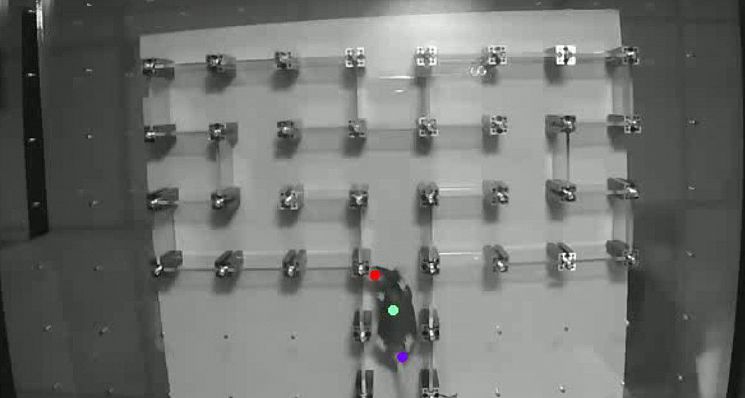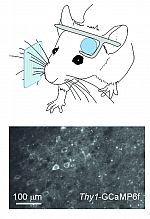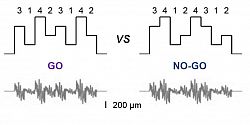 A mouse freely exploring a labyrinth where it can encounter tactile stimuli that will predict choices and rewards
A mouse freely exploring a labyrinth where it can encounter tactile stimuli that will predict choices and rewards
To make sense of the world around us, the brain must discriminate stimuli that are structured in space and time. Our group explores the principles that make this possible. Recent and ongoing work analyses how different processing stages in a sensory pathway represent, use and transform information, leading from the raw physical signals that are sampled by sensory receptors to the elaborate stimulus features that underlie sensation, perception and prediction.
We work mainly on the cerebral cortex, the sheet that forms the outer surface of the mammalian brain. Neural circuits in this area underpin perception, decision making and cognition. Diseases that perturb the normal establishment of cortical circuits, such as schizophrenia and autism spectrum disorders, often cause impairments in the transformation and integration of sensory information. In addition to studying the cortex, we also investigate how information is represented in sensory stages that provide input to the cortex, in order to understand the messages that cortical circuitry must process. But our experiments focus mainly on the part of sensory cortex that receives somatosensory (tactile) input from the whiskers, known as the “barrel cortex” for the particular shape of the clusters of neurons that constitute the first cortical stage for whisker processing.
Some of our most recent findings have highlighted how, in this part of sensory cortex, sensory responses mesh with neuronal activity reflecting an animal's upcoming actions and their consequences. Neurons in sensory cortex are involved in task-specific processing and –as a consequence– an animal does not, in effect, sense the world independently of what it needs to feel in order to guide behaviour. Instead, the sensations are deeply enmeshed in the task itself. These findings connect to ideas of predictive coding and with theories of embodied sensing, and these inform our thinking about the experiments we will need to do to improve our understanding of "sensory" neuronal circuits and the responses they produce.
Some of our recent findings are shown in the boxes below.
We use multiple experimental approaches and levels of description.
- We assess performance on sensory tasks in mice and in humans, allowing us to compare and benchmark animal and human capacities on analogous types of sensory discrimination.
- We measure neuronal responses using single-cell and population electrophysiological recording and two-photon fluorescence imaging, applied ex vivo in brain slices, and in vivo in animals performing sensory tasks. We also manipulate responses using optogenetics.
- An important part of our work involves tailoring and applying new analytical tools to extract information from these data. We have applied methods of information theory, dimensional reduction and decoding to sensory responses in the whisker system and this has produced new insights into how neuronal populations process information.
- Sensory and non-sensory neuronal activity in the barrel cortex
-

Diagram showing a mouse receiving sequences of vibrations presented to the whiskers (above), while the activity of neurons in its primary somatosensory “barrel” cortex is recorded using two-photon calcium imaging (below). Using these techniques we have shown that neurons in barrel cortex respond to variables beyond sensory information, including the animal's upcoming task-related actions (licking for a reward when the target sequence is perceived) and the outcomes of those actions. We have also shown that neuronal activity in barrel cortex is needed to perform the task. Bale et al, 2021.
- Sequence discrimination in mice and humans
-

A temporal sequence discrimination task. Making sense of the world demands the ability to discriminate temporally patterned stimuli. To better understand the neuronal processing underlying this capacity, we established a family of sequence discrimination tasks that allow us to measure and compare human and mouse performance. Vibrations are applied to the fingertip (human) or whiskers (mouse). Target (GO) and non-target (NO-GO) stimuli are composed of “noise” multiplied by a sequence of amplitudes (top). The target stimulus (GO) differs from the NO-GO only in that its temporal patterning over a timescale of ~100 milliseconds is scrambled (note the different ordering of the constituent segments). For both humans and mice, performance averages 70-75% across the population. Bale et al, 2017.
- Information about temporal patterns conveyed by neuronal responses
-

Whisker deflections generated at random intervals (top) and a simultaneous "patch clamp" recording of a single neuron’s responses in the mouse barrel cortex (bottom). By spiking, this single cell reliably reports whisker deflections that occur after intervals, but only when those intervals are long enough. This implies that the cell provides information about the interval between deflections. Neurons in the barrel cortex are good at conveying such information about the ongoing stimulus, but convey relatively weak information about what happened more than a few hundred ms ago. So neurons in barrel cortex report what is going on now, but neurons in other parts of the cortex are needed to hold and compare information about what went on in the past. Pitas et al, 2017.

